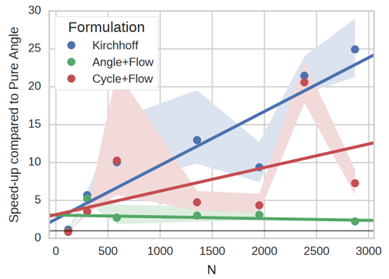Energy Networks and Complex Systems
About
The research group Energy Networks and Complex Systems develops mathematical methods and tools for the stable operation of electric power grids. One focus of our work is the stability and robustness against outages and equipment failures. We use simulations and concepts of mathematical graph theory to understand what makes a power grid vulnerable and how we can design stable and robust networks. A second focus is power system control and the interactions with other parts of the energy system. Using method from machine learning, we quantify and explain how external influences and perturbations affect the operation of the power system.
Research Topics
Algebraic graph theory and its applications
Explainable and causal machine learning for energy system applications
Load-frequency control
Robustness of transmission grids and cascading failures
Optimization of grid topologies
Members
RESEARCH FIELDS
Algebraic graph theory and its applications
We use concepts of algebraic graph theory to analyze the robustness of energy grids and develop algorithms for power systems analysis and operation. The figure below shows that common optimization problems in power system planning can be solved much faster by reformulating the underlying network equations.

(For more details see https://doi.org/10.1016/j.epsr.2017.12.034)
Explainable and causal machine learning for energy system applications
The energy transition leads to a tremendous growth in complexity and uncertainty. At the same time, large amounts of data are becoming available that enable new insights into the operation of energy and power systems. We apply tools from (causal) statistics and machine learning to improve our understanding of the complex interactions of different systems and markets.
The figure below shows communities of electricity markets before and during the European electricity crisis. Communities of strongly integrated markets in Northern and Eastern Europe were shattered as they responded differently to the crisis.

(For more details see https://doi.org/10.1063/5.0201734)
Load-frequency control
The grid frequency is one of the central observables in power system control as it measures the balance of generation and load. It is used to control the operation of reserve power plants that restore the balance in the grid in real-time. We develop transparent machine learning methods to identify threats to frequency stability and to forecast control needs. The figure below shows the architecture of a physics-informed ML model for the probabilistic prediction of frequency trajectories.

(Figure reproduced from https://doi.org/10.1103/PRXEnergy.2.043003)
Robustness of transmission grids and cascading failures
Cascading failures are among the most severe threats to power grid stability. The outage of a single transmission can trigger a domino effect leading to further outages and eventually a fragmentation of the grid. We analyze the risk of such cascading failures using both analytic methods and large scale simulations. The figure below shows how a modified grid topology can suppress the spreading of outages and thus suppress large-scale cascades.

(Figure reproduced from https://doi.org/10.1038/s41467-021-23292-9)
Optimization of grid topologies
The energy transition leads to increasing loads in the high-voltage transmission grids. Transmission system operators have to intervene frequently to mitigate congestion and keep the grid stable. These measures cause costs of billions of euros and cause additional greenhouse gas emissions. Dynamic topology reconfiguration is a promising measure to manage congestion with existing infrastructures. Topology optimization is mathematically challenging such that novel algorithms are required to realize this option.

